
Rice terraces, forest and native houses in Bangaan, Banaue, Philippines. The Cambulo is similar.
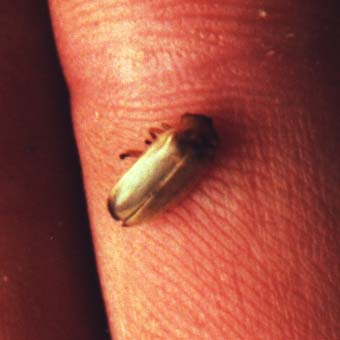
A real firefly, it is a magnificent sight to see thousands of them light up a large tree.
Where it started: PRRM-Ifugao, Philippines
| PRRM is an NGO in the Philippines dedicated to bringing development especially to the poorest people (see also www.prrm.org/index.htm). I worked at PRRM-Ifugao Branch as a VSO volunteer from July 1990 to December 1992. Originally, my job was to help introducing a form of sustainable agriculture. The last 10 months, I worked on developing this firefly Micro Hydro system, testing it and introducing it in Cambulo, a remote village that was chosen as pilot village. | |

Rice terraces, forest and native houses in Bangaan, Banaue, Philippines. The Cambulo is similar. |
 A real firefly, it is a magnificent sight to see thousands of them light up a large tree. |
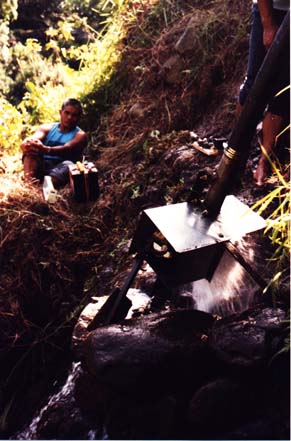 The Cambulo charger charging its first battery. |
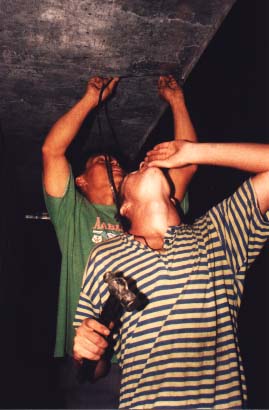 Ben Nanglihan and my brother Ruud wiring up Ben's house. Ruud did a lot of work in the Cambulo pilot project. |
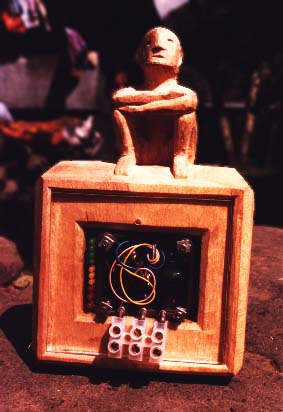 A charge indicator. Rice-god Bulol is watching over it. |
| After I left the
Philippines, it took nearly a year before my successor mr.
Simon Taylor arrived. About half a year before, the
Cambulo prototype broke down. In an attempt to repair it,
the users made wrong connections and it got even more
damaged. With the help of Simon, the prototype charger
was repaired again. But by that time, most batteries of
users must have been worn out because of being left in
discharged condition for too long. Simon wrote numerous letters asking for help on technical matters, especially on the electrical wiring. Often it was difficult to find out what had actually gone wrong, so my replies became long letters as I tried to answer all possible cases. Paid for by VSO, I sent the second prototype that I had build in Holland, to PRRM. In total, at least 4 chargers were installed by PRRM-Ifugao while Simon worked there. Simon doubted whether the technology was simple enough for farmers to build and maintain. My building manual was not yet available so he had to learn technical tricks the hard way: By trial and error. Simon also complained that most potential users expected PRRM to subsidize a substantial part of all material costs. Clearly the enthousiasm that the firefly idea had generated during the10 months that I had worked on it, had worn off. Maybe potential users saw that PRRM could not solve technical problems right away and this made them less confident about investing their own money. |
|
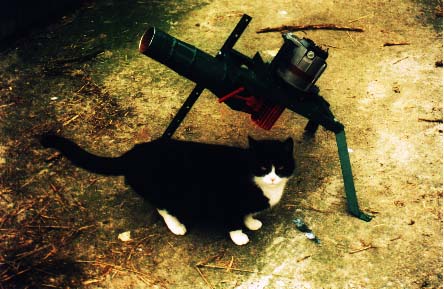 The second prototype that I built in Holland and was later sent to PRRM: Not much larger than a fat Dutch cat. This one has an adjustable nozzle, see also Technical issues /adjustable nozzle. |
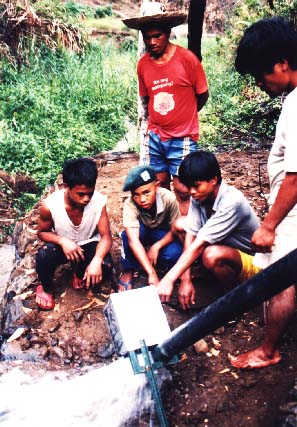 Charger and beneficiaries in Potad, installed by Simon Taylor (photo: Simon Taylor) |
| Personal
comment (by Jan Portegijs): Within PRRM, there was a strong focus on organization building. This 'community approach' made that introducing the firefly was not seen as a goal in itself, but as a means towards this higher goal of organizing poor people into strong, self-confident communities that could take its future in its own hands. Consequently, PRRM wanted its firefly chargers to be community-owned. PRRM was not in favour of a role for small businessmen in introducing the firefly, e.g. by buying a charger and charging batteries of neighbours for a fee, by building, installing and repairing chargers, by trading in batteries and other materials etc. Simon fitted in well with this approach: He learned two native languages, he liked to mingle with local people and he was not that focussed on solving all technical problems that might crop up. Maybe the firefly could have been introduced more widespread and much faster by linking in with private initiatives. In my opinion, introducing the firefly could have been a goal in itself: It is a renewable source of energy that improves living conditions for rural poor by providing electrical light, savings on dry cell batteries for radio's etc. Then if the firefly would become an inspiring success, this might make people more confident and spark off initiatives to deal with other, more serious problems. End of 1994, Simon got to know Engr. Angelito V. Angeles and Engr. John F. Malamug of resp. CLSU-ANEC and BSU-ANEC. They became enthousiastic about the firefly and wanted to use it for their Micro Hydro programme. They had a sound technical background, access to a metal workshop and they helped PRRM in building chargers. Together with PRRM-Ifugao, they organised a 'seminar and study tour on M.H. for battery charging', with mainly people from 17 other ANEC's as participants. |
|
Simon Taylor moved to PRRM Central Office in 1997. By that time, PRRM got more interested in "Kilowatt-level" Micro-hydro (so: with 230 V AC output and a local grid instead of battery charging) and they had installed a 3 kW system in Gode. The Vice President of the Philippines was present during the inauguration, so a big publicity success. From a technical point, success was less likely as the generator had no AVR (for output voltage regulation) and there was no ELC (for frequency regulation). They thought about buying an ELC from me, if they could find the funds. In 1998, not much was achieved due to lack of funds. Simon worked on a manual on how to plan, build and execute a Firefly project. He wrote that SIBAT (an NGO active in Renewabe Energy etc.) had counted some 30 Firefly systems all over the Philippines.
In 1999, PRRM was seriously planning 4 "Kilowatt level" M.H. systems. Their capacities ranged from 5.5 to 20 kW, with the 2 heaviest ones being 3-phase systems. They wanted to buy the ELC's with me so I made a price quotation and designed the 3-phase version of my "Humming Bird" ELC design The order was never confirmed and in January 2001, I wrote PRRM that I withdrew my price quotation. I did not hear from Simon until March 2003. He had left PRRM in 2000 and now worked for IT Power, Reading, England on Pico Hydro (= very small Micro Hydro, like the Firefly design) and Marine Current Turbines. He was reminded of the Firefly by a colleague of IT India who was taking a Firefly up to the hills, for his own power supply. He was about to return to Ifugao, probably for a family visit since his wife comes from Ifugao. He wanted to find out how many of the 5 or 6 PPRM Firefly systems that were working in 2000, were still operational. |
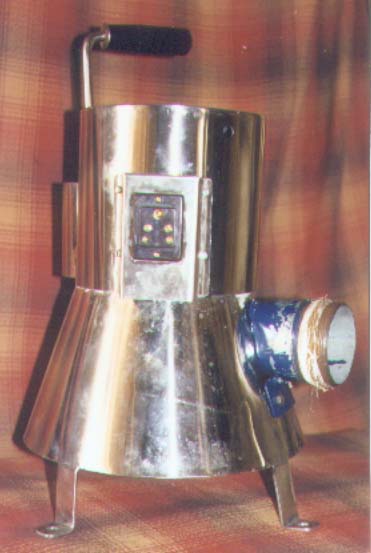 The firefly charger of IT Power India.
For more info on PRRM's activities: |